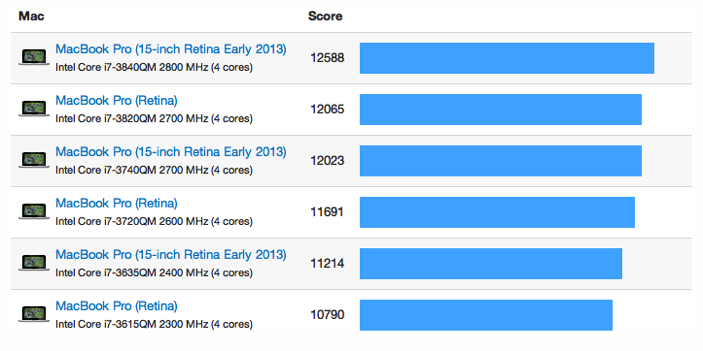Last week Apple quietly updated their Retina MacBook Pro lineup with faster processors. The 15-inch Retina MacBook Pro now comes with a 2.4 GHz, 2.7 GHz, or a 2.8 GHz quad-core processor. The 13-inch Retina MacBook Pro now comes with a 2.5 GHz, 2.6 GHz, 2.9 GHz, or 3.0 GHz dual-core processor.
How do these new Retina MacBook Pro models perform compared to the original models? To find out I’ve collected Geekbench 2 results from the Geekbench Browser for all of the Retina MacBook Pro models and charted the scores below.
If you’re not familiar with Geekbench, it’s our cross-platform benchmark utility. Higher Geekbench scores are better, where twice the score means twice the performance. If you’re curious how your computer compares, you can download Geekbench to find out.
15-inch Retina MacBook Pro
Below is a summary of the processor upgrades for the different 15-inch Retina MacBook Pro models:
| 15-inch Retina Mid 2012 | 15-inch Retina Early 2013 | |
|---|---|---|
| Low | Core i7-3615QM @ 2.3 GHz | Core i7-3635QM @ 2.4 GHz |
| Mid | Core i7-3720QM @ 2.6 GHz | Core i7-3740QM @ 2.7 GHz |
| High | Core i7-3820QM @ 2.6 GHz | Core i7-3840QM @ 2.7 GHz |
Each model received a 100 MHz increase in processor speed. Besides the differences in speed, the processors for each model have the same specifications.
So, how do the new 15-inch MacBook Pros perform?
The new processors bring between a 3% to 5% increase in performance to each MacBook Pro model according to the Geekbench 2 scores. This increase is entirely due to, and in line with, the increase in processor speed.
One thing to note is that the new mid-range Retina MacBook Pro has the same speed processor as the old high-end Retina MacBook Pro. However, the new mid-range model is slightly slower than the old high-end model. While this seems surprising at first, the difference is easily explained by comparing the two processors: the old high-end processor has more cache than the new mid-range processor.
13-inch Retina MacBook Pro
Here is a summary of the processor upgrades for the different 13-inch Retina MacBook Pros:
| 13-inch Retina Late 2012 | 13-inch Retina Early 2013 | |
|---|---|---|
| Low | Core i5-3210M @ 2.5 GHz | Core i5-3230M @ 2.6 GHz |
| High | Core i7-3520M @ 2.9 GHz | Core i7-3540M @ 3.0 GHz |
Like the 15-inch Retina MacBook Pro, each 13-inch Retina MacBook Pro model receives a 100 MHz increase in processor speed.
However, unlike the 15-inch Retina MacBook Pro, which only ships with the new processors, the 13-inch Retina MacBook Pro ships with both the old and the new processors. The old processors appear in 13-inch models that start with 128GB of storage, while the new processors appear in 13-inch models that start with 256GB of storage.
How do the new 13-inch MacBook Pros perform?
It turns out the new 13-inch MacBook Pros receive a boost similar to the new 15-inch MacBook Pros. The new processors bring a 3% to 5% increase in performance according to their Geekbench 2 scores. Again, this increase is in line with the increase in processor speed.
Final Thoughts
With Haswell, Intel’s new processor architecture, at least four months away, I’m not surprised Apple updated the Retina MacBook Pro lineup with the latest Ivy Bridge processors. I am surprised Apple didn’t update the MacBook Pro lineup at the same time. Both the 13-inch and 15-inch MacBook Pro come with the older Ivy Bridge processors (although you can upgrade the 15-inch MacBook Pro to the newer Ivy Bridge processors). I wonder if this is an indication that the Retina MacBook Pro is more popular than the MacBook Pro, or perhaps that this is the last generation of the MacBook Pro.
I imagine we’ll find out what happens to the MacBook Pro later this year when Apple releases new Haswell-based laptops.

